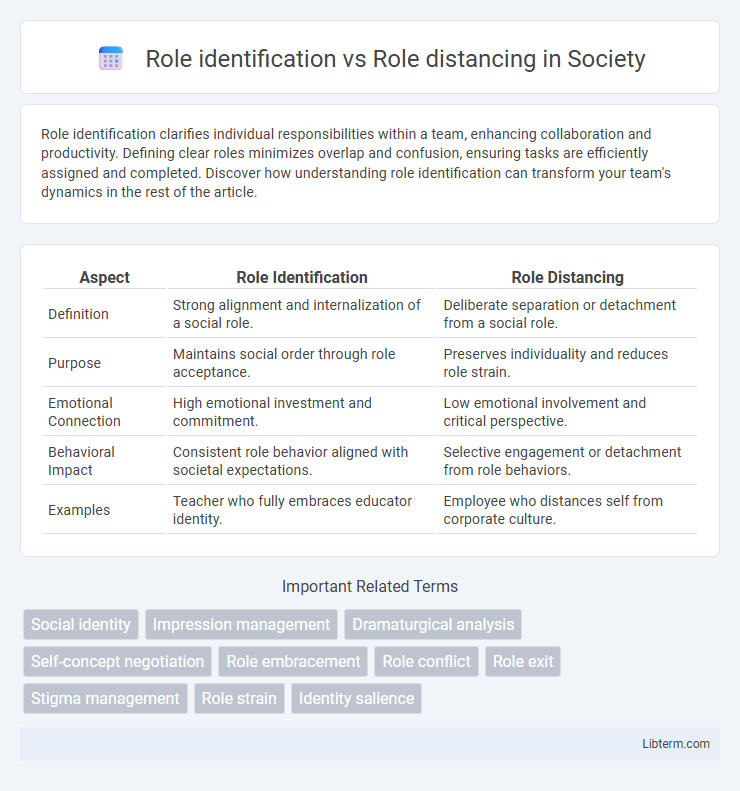Role identification clarifies individual responsibilities within a team, enhancing collaboration and productivity. Defining clear roles minimizes overlap and confusion, ensuring tasks are efficiently assigned and completed. Discover how understanding role identification can transform your team's dynamics in the rest of the article.
Table of Comparison
| Aspect | Role Identification | Role Distancing |
|---|---|---|
| Definition | Strong alignment and internalization of a social role. | Deliberate separation or detachment from a social role. |
| Purpose | Maintains social order through role acceptance. | Preserves individuality and reduces role strain. |
| Emotional Connection | High emotional investment and commitment. | Low emotional involvement and critical perspective. |
| Behavioral Impact | Consistent role behavior aligned with societal expectations. | Selective engagement or detachment from role behaviors. |
| Examples | Teacher who fully embraces educator identity. | Employee who distances self from corporate culture. |
Understanding Role Identification
Understanding role identification involves individuals fully embracing and internalizing the norms, behaviors, and expectations associated with a specific social or professional role. This process strengthens self-concept and social cohesion by aligning personal identity with group or societal roles. Effective role identification enhances commitment, motivation, and the ability to fulfill role responsibilities with authenticity.
Defining Role Distancing
Role distancing refers to the conscious or unconscious process by which individuals separate themselves from the roles they occupy to maintain personal identity and autonomy. It involves behaviors and attitudes that signal detachment or disengagement from expected role behaviors, allowing individuals to manage social expectations without fully internalizing the role. This concept is crucial in sociology and psychology for understanding how people navigate conflicting demands between social roles and self-perception.
Psychological Foundations of Roles
Role identification involves internalizing societal or organizational expectations, leading individuals to align their behavior and self-concept with their assigned roles based on psychological theories like symbolic interactionism and social identity theory. In contrast, role distancing occurs when individuals maintain a psychological separation between their self-identity and their role behaviors, often as a defense mechanism to protect the authentic self from role-induced stress or stigma. Psychological foundations emphasize how role identification promotes social cohesion and self-consistency, while role distancing supports autonomy and emotional regulation in complex social interactions.
Social Contexts Influencing Roles
Role identification occurs when individuals fully internalize social roles based on expectations within family, workplace, or cultural settings, leading to consistent behavior aligned with these roles. Role distancing emerges as a conscious effort to separate one's self-identity from assigned roles to resist stereotyping or maintain personal autonomy in social interactions. Social contexts such as power dynamics, cultural norms, and group membership significantly influence whether individuals engage in role identification or role distancing.
Benefits of Role Identification
Role identification enhances employee engagement by fostering a strong connection between individuals and their organizational roles, leading to higher job satisfaction and performance. Embracing role identity promotes consistency in behavior and aligns personal goals with company objectives, boosting overall productivity. This psychological alignment reduces workplace stress and turnover rates, cultivating a committed and motivated workforce.
Challenges of Excessive Role Identification
Excessive role identification can lead to blurred boundaries between personal identity and professional responsibilities, causing emotional exhaustion and diminished work-life balance. Individuals may experience increased stress and job dissatisfaction as they struggle to separate their self-worth from their occupational role. This over-immersion often results in decreased adaptability and reduced capacity to engage in diverse social interactions outside the workplace.
Advantages of Role Distancing
Role distancing enhances individual autonomy by allowing people to separate their personal identity from assigned social roles, reducing potential stress and role strain. It fosters critical awareness of social expectations, enabling individuals to challenge or redefine limiting stereotypes and behaviors. This psychological flexibility promotes creativity and adaptive responses in complex social environments, improving overall social interaction quality.
Drawbacks of Role Distancing
Role distancing often leads to a lack of authenticity and decreased trust within social or organizational contexts, impairing relationship building and effective communication. This behavior can result in social isolation as individuals detach from group norms and responsibilities, reducing cohesion and collaboration. Furthermore, prolonged role distancing may contribute to identity confusion and diminished self-esteem, negatively affecting overall psychological well-being.
Balancing Identification and Distancing
Balancing role identification and role distancing requires individuals to engage deeply with their social or professional roles while maintaining a critical perspective that prevents over-immersion or loss of self. Effective management of this balance enhances psychological well-being and interpersonal effectiveness by allowing one to adapt flexibly to situational demands without rigidly adhering to prescribed behaviors. Research in social psychology emphasizes that strategic distancing enables reflection and resilience, whereas strong role identification fosters commitment and belonging within groups or organizations.
Practical Implications in Everyday Life
Role identification entails deeply internalizing and embodying the expectations and behaviors associated with a social position, leading to consistent and coherent interactions in family, work, and community settings. Role distancing involves maintaining an emotional or psychological separation from a social role, which can reduce stress and preserve personal autonomy but may also create challenges in fulfilling social obligations and building trust. Understanding the balance between role identification and role distancing is crucial for managing interpersonal relationships, enhancing job performance, and promoting mental health in daily life contexts.
Role identification Infographic

 libterm.com
libterm.com